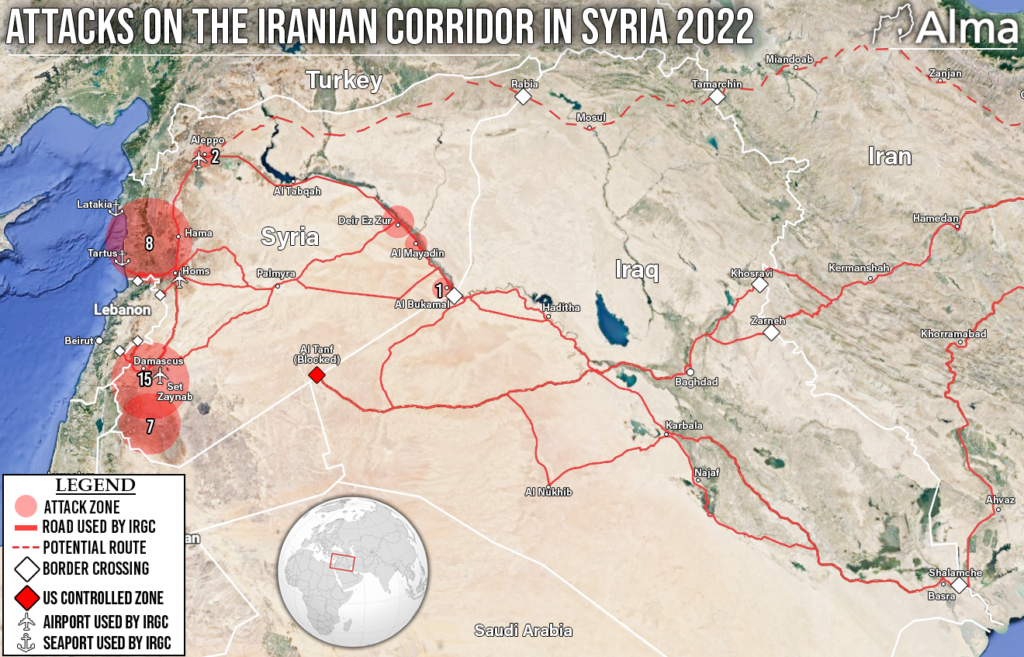For a very long time, the Iranians have suffered operational failures outside of Iran and on Iranian soil. The main operational failure outside of Iran is reflected in the CBW attacks in Syria, which severely disrupted the Iranian arms corridor to Syria and Lebanon and undermined Iran’s strategic vision. The main operational failure on their soil is evident in numerous assassinations of officials associated with nuclear or advanced military weapons projects and the damage to strategic military sites.

The desire for revenge leads the Iranians to try and carry out operative actions such as kinetic actions or abduction/assassination operations directly against Israeli territory or Israeli interests and personalities worldwide. Most of these attempts have failed or have been foiled, further undermining the Iranians’ national pride.
The Iranians are obstinate and patient people. Despite the operational failures and the damage to their pride, they constantly try to act against Israel and occasionally succeed. Iranian UAV attacks on Israeli-affiliated merchant ships on international trade routes in the Gulf of Oman continue. Just last February, two such attacks were carried out. While the attacks did not cause real damage, the Iranians are positioning their emphasis on the battle for the hearts and minds. Just recently (about three weeks ago), an Iranian attack group called MuddyWater managed to carry out a successful cyberattack on the Technion in Haifa. This attack group is affiliated with the Iranian Ministry of Intelligence and Defense. The damage from the attack is unknown to us, but here, too, the battle for hearts and minds is a major player.
Undoubtedly, the American military exercises in the Middle East, in which Israel and the moderate Arab countries participate, further increase the Iranian sense that the attack on their nuclear facilities is near and that they feel they are with their backs to the wall.
Do the American exercises, the operational failure to respond to the CBW, and the failure to respond to the attacks in its territory lead to an increase in Iranian propaganda and perception warfare as a temporary solution in the absence of an operational solution? The answer to this is probably yes.
Undoubtedly, the Iranians are powerful in developing, manufacturing weapons, and constructing underground sites. Even the Russians “surrendered” their national pride and began purchasing UAVs, missiles, and even “ordinary” weapons from the Iranians, such as bullets, mortar shells, and rockets.
In the past month, weapons development, production, and underground sites have been a central motif in Iran’s propaganda and battle for hearts and minds. The messages are aimed primarily at Israel and their purpose: the Iranian nuclear sites will survive a future attack, and Iran has the ability to counterattack with a variety of means.
On February 7, the Iranians showcased an underground facility used as an air force base about 150 kilometers from Bandar Abbas. The videos and photos show a large infrastructure of tunnels with Phantom (obsolete) jets moving inside them. The main issue is not the airplanes. The main point is the Iranians’ impressive underground capability, which shows their ability to cope with a possible attack. It is clear to everyone that Iran’s nuclear facilities are entrenched in sounder underground infrastructure than what is publicly displayed.
At the same time, an advertising blitz began on additional weapons systems. For example, the UAV we know of, the Shahad 149 type (nicknamed “Gaza”), which the Iranians see as a strategic platform (very long range, prolonged flying duration, diverse armaments, etc.). In addition, the commander of the IRGC’s Air and Space Force, Amir Ali Hajizadeh, unveiled a new cruise missile called the Paveh with a range of 1650 kilometers, which could reach Israel from Iranian territory. In addition, Hajizadeh said that Iran has developed a hypersonic missile (faster than the speed of sound) that reaches speeds of up to Mach 13, which existing defense systems have difficulty intercepting.
As a direct response to the CBW, on February 25, Iranian news agencies published a new defense array called Khordad 15, which is supposed to be an improved defense array for Syrian skies carrying missiles that can reach a range of between 75 and 120 km, with a radar capability of engaging 6 targets simultaneously.
The Iranians are threatening. Will they bite too? Factually, as noted above, the Iranians manage to respond (albeit with low intensity) and are constantly trying to take revenge for the actions carried out against them.
As for the response to a high-profile overt attack on their territory, the Iranians will bite. It is even possible that the bite will be more robust than what we have witnessed so far and will also have a high profile and be more powerful both directly from their territory and through their proxies throughout the Middle East.






